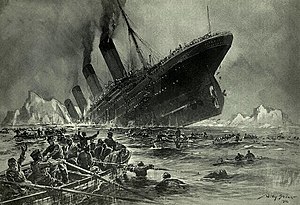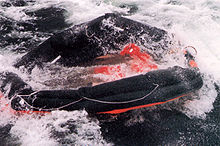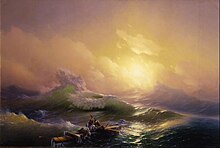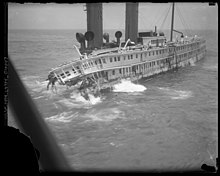
A ship is a large vessel that travels the world's oceans and other navigable waterways, carrying cargo or passengers, or in support of specialized missions, such as defense, research and fishing. Ships are generally distinguished from boats, based on size, shape, load capacity and purpose. Ships have supported exploration, trade, warfare, migration, colonization, and science. Ship transport is responsible for the largest portion of world commerce.

SS Edmund Fitzgerald was an American Great Lakes freighter that sank in Lake Superior during a storm on November 10, 1975, with the loss of the entire crew of 29 men. When launched on June 7, 1958, she was the largest ship on North America's Great Lakes and remains the largest to have sunk there. She was located in deep water (§ Wreck discovery below) on November 14, 1975, by a U.S. Navy aircraft detecting magnetic anomalies, and found soon afterwards to be in two large pieces.

A shipwreck is the wreckage of a ship that is located either beached on land or sunken to the bottom of a body of water. Shipwrecking may be intentional or unintentional. There were approximately three million shipwrecks worldwide as of January 1999, according to Angela Croome, a science writer and author who specialized in the history of underwater archaeology.

The metacentric height (GM) is a measurement of the initial static stability of a floating body. It is calculated as the distance between the centre of gravity of a ship and its metacentre. A larger metacentric height implies greater initial stability against overturning. The metacentric height also influences the natural period of rolling of a hull, with very large metacentric heights being associated with shorter periods of roll which are uncomfortable for passengers. Hence, a sufficiently, but not excessively, high metacentric height is considered ideal for passenger ships.

TEV Wahine was a twin-screw, turbo-electric, roll-on/roll-off passenger ferry. Ordered in 1964, the vessel was built by the Fairfield Shipbuilding and Engineering Company, in Govan, Glasgow, Scotland for the Union Steam Ship Company's Wellington-Lyttelton Steamer Express Service in New Zealand.
This glossary of nautical terms is an alphabetical listing of terms and expressions connected with ships, shipping, seamanship and navigation on water. Some remain current, while many date from the 17th to 19th centuries. The word nautical derives from the Latin nauticus, from Greek nautikos, from nautēs: "sailor", from naus: "ship".

Capsizing or keeling over occurs when a boat or ship is rolled on its side or further by wave action, instability or wind force beyond the angle of positive static stability or it is upside down in the water. The act of recovering a vessel from a capsize is called righting. Capsize may result from broaching, knockdown, loss of stability due to cargo shifting or flooding, or in high speed boats, from turning too fast.

SS Marine Electric was a 605-foot bulk carrier that sank on 12 February 1983, about 30 miles off the coast of Virginia, in 130 feet of water. Thirty-one of the 34 crewmembers were killed; the three survivors endured 90 minutes drifting in the frigid waters of the Atlantic. The wreck resulted in some of the most important maritime reforms in the second half of the 20th century. The tragedy tightened inspection standards, resulted in mandatory survival suits for winter North Atlantic runs, and helped create the now famous Coast Guard rescue swimmer program.

SS Schiller was a 3,421-ton German ocean liner, one of the largest vessels of her time. Launched in 1873, she plied her trade across the Atlantic Ocean, carrying passengers between New York City and Hamburg for the German Transatlantic Steam Navigation Line. She became notorious on 7 May 1875, while operating on her normal route, when she hit the Retarrier Ledges in the Isles of Scilly, causing her to sink with the loss of most of her crew and passengers, totaling 335 fatalities.
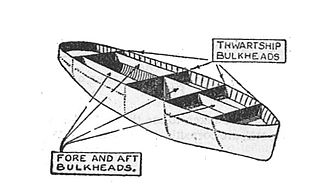
Floodability is the susceptibility of a ship's construction to flooding. It also refers to the ability to intentionally flood certain areas of the hull for damage control purposes, or to increase stability, which is particularly important in combat vessels, which often face the possibility of serious hull breach due to enemy action, and which rely on well-trained damage controlmen to equalize and then stop flooding of the hull.

Marine salvage is the process of recovering a ship and its cargo after a shipwreck or other maritime casualty. Salvage may encompass towing, lifting a vessel, or effecting repairs to a ship. Protecting the coastal environment from oil spillages or other contaminants from a modern ship can also be a motivator, as oil, cargo, and other pollutants can easily leak from a wreck.

The MS al-Salam Boccaccio 98 was an Egyptian Ro/Ro passenger ferry, operated by El Salam Maritime Transport, that sank on 3 February 2006 in the Red Sea en route from Duba, Saudi Arabia, to Safaga in southern Egypt.
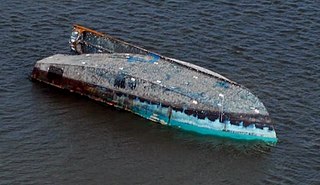
In dinghy sailing, a boat is said to be turtling or to turn turtle when the boat is fully inverted with the mast pointing down to the lake bottom, riverbed, or seabed. The name stems from the appearance of the upside-down boat, similar to the carapace of a sea turtle. The term can be applied to any vessel; turning turtle is less frequent but more dangerous on ships than on smaller boats. It is rarer but more hazardous for multihulls than for monohulls, because multihulls are harder to flip in both directions. Measures can be taken to prevent a capsize from becoming a turtle.

SS Valencia was an iron-hulled passenger steamer built for the Red D Line for service between Venezuela and New York City. She was built in 1882 by William Cramp and Sons, one year after the construction of her sister ship Caracas. She was a 1,598-ton vessel, 252 feet (77 m) in length. In 1897, Valencia was deliberately attacked by the Spanish cruiser Reina Mercedes off Guantanamo Bay, Cuba. The next year, she became a coastal passenger liner on the U.S. West Coast and served periodically in the Spanish–American War as a troopship to the Philippines. Valencia was wrecked off Cape Beale, which is near Clo-oose, on the west coast of Vancouver Island, British Columbia, on 22 January 1906. As her sinking killed 100 people, some classify the wreck of Valencia as the worst maritime disaster in the "Graveyard of the Pacific", a famously treacherous area off the southwest coast of Vancouver Island.

Ship grounding or ship stranding is the impact of a ship on seabed or waterway side. It may be intentional, as in beaching to land crew or cargo, and careening, for maintenance or repair, or unintentional, as in a marine accident. In accidental cases, it is commonly referred to as "running aground".
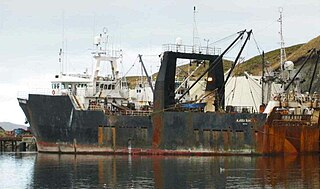
FV Alaska Ranger was a fishing factory ship owned and operated by the Fishing Company of Alaska of Seattle, Washington. The ship was constructed in 1973 for use as an oil field service vessel. The ship sank 23 March 2008, after reporting progressive flooding only hours earlier. Of the 47 on board, 42 were rescued. Of the five fatalities, four were recovered dead, and one was never found. The Coast Guard was initially misinformed about the number of persons on board the vessel, and secured the search with one crew member still unaccounted for. After realizing there was still one person missing, the Coast Guard reinstated the search, but did not find the crew member.

The sinking of MV Teratai Prima occurred on 11 January 2009, around 04:00 local time when a ferry carrying more than 300 people capsized in the Makassar Strait off West Sulawesi, Survivors stated that the ferry had been slammed by 4-metre (13 ft) waves twice. The first one hit so hard that the ship became unbalanced, before another wave hit from a different direction and sank the vessel.

The Scilly naval disaster of 1707 was the loss of four warships of a Royal Navy fleet off the Isles of Scilly in severe weather on 22 October 1707. Between 1,400 and 2,000 sailors lost their lives aboard the wrecked vessels, making the incident one of the worst maritime disasters in British naval history. The disaster has been attributed to a combination of factors, including the navigators' inability to accurately calculate their positions, errors in the available charts and pilot books, and inadequate compasses.

SS El Faro was a United States-flagged, combination roll-on/roll-off and lift-on/lift-off cargo ship crewed by U.S. merchant mariners. Built in 1975 by Sun Shipbuilding & Drydock Co. as Puerto Rico, the vessel was renamed Northern Lights in 1991 and, finally, El Faro in 2006. She was lost at sea with her entire crew of 33 on October 1, 2015, after steaming into the eyewall of Hurricane Joaquin.
This glossary of nautical terms is an alphabetical listing of terms and expressions connected with ships, shipping, seamanship and navigation on water. Some remain current, while many date from the 17th to 19th centuries. The word nautical derives from the Latin nauticus, from Greek nautikos, from nautēs: "sailor", from naus: "ship".
